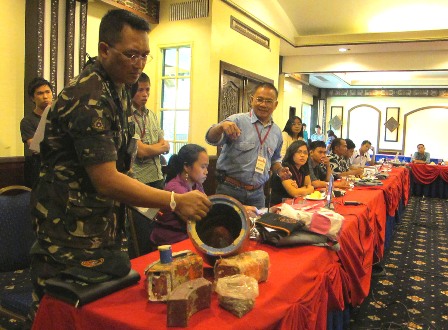DAVAO CITY (MindaNews/03 October) — The old water pump lying on the roadside in Maguindanao province appeared harmless except that the rusty foot-long cylinder was filled with explosives strong enough to cause considerable damage to lives and properties.
Found in Barangay Lower Salvo, Datu Saudi Ampatuan town in Maguindanao on June 13, 2009, the improvised explosive device or IED, can be triggered by a Nokia 3310 phone when the intended targets pass by—a deadly version of a locally manufactured landmine.
Major Ramon Torres, chief of the Explosives Ordnance Disposal unit of the 10th Infantry Division said the New People’s Army, Moro Islamic Liberation Front and Abu Sayyaf prefer to manufacture their own versions of IED because of the availability of explosives and materials.
 Samples of deactivated IEDs. MindaNews photo by Froilan Gallardo
Samples of deactivated IEDs. MindaNews photo by Froilan Gallardo
“They cannot get hold of landmines manufactured in other countries so they make their own versions of landmines. It still has the same deadly effect,” Torres told Mindanao-based journalists who attended a training on reporting landmines and landmine incidents, at the
Waterfront Insular Hotel here on Saturday.
Three rebel groups in the Philippines have signed the Geneva Call Deed of Commitment for Adherence to Total Ban on Anti-Personnel Landmines and Cooperation in Mine Action, according to Chris Rush, senior programme officer of Geneva Call who was the resource person in the training.
These are the Moro Islamic Liberation Front and two groups that broke away with the Communist Party of the Philippines-New People’s Army, namely, the Revolutionary Proletarian Army-Alex Boncayao Brigade (RPA-ABB) and the Rebolusyonaryong Partido ng Manggagawa ng Mindanao (RPM-M), he said.
The NPA has maintained that their use of command-detonated landmines does not violate the 1997 Ottawa Treaty which bans the use of anti-personnel landmines.
The Armed Forces of the Philippines said it is no longer using landmines in its anti-insurgency campaign, adding that in 1998 it destroyed all of its stockpiles including claymore landmines.
The Philippines is a party to the Convention on Conventional Weapons and the Amended Protocol II on landmines as well as the Ottawa Treaty.
“Reports of how many casualties or how many incidents involving IEDs or landmines vary because details in past reporting are unclear. It can be higher,” Rush said.
According to the 10th Infantry Division, 16 persons (11 soldiers and 5 civilians) in Southern Mindanao have died from IEDs as of Sept. 2010. Thirty-two civilians and 30 soldiers were injured in the same incidents.
The Landmine and Cluster Monitor said 461 persons have been killed or injured from victim-detonated landmines and unexploded ordnance left in the battlefields of Mindanao. The NGO said many of the casualties were children, soldiers and policemen.
Geneva Call has called on combatants worldwide to stop the use of anti-personnel landmines to prevent casualties among civilians and other protected persons.
“The injuries they cause, such as the loss of limbs, are horrific. It disables those who survive for life,” he said.
Rush said landmines can remain unexploded for many years endangering the lives of people who live in or near landmine-contaminated areas long after the hostilities have ended.
Journalists from all over Mindanao attended the one-day training on how to properly report incidents involving the use of IEDs and landmines.
The training was organized by Geneva Call and MindaNews. (Froilan Gallardo/MindaNews)
